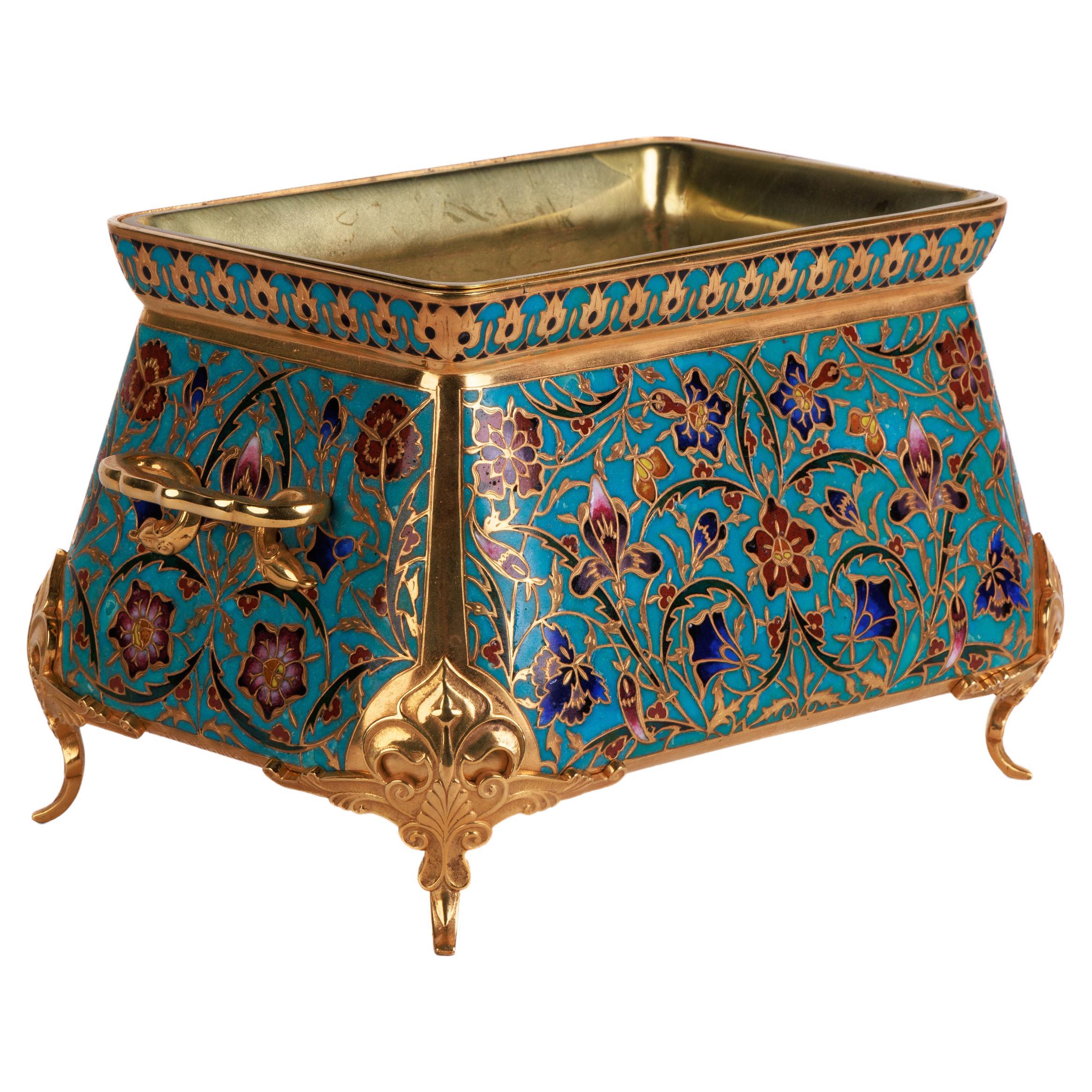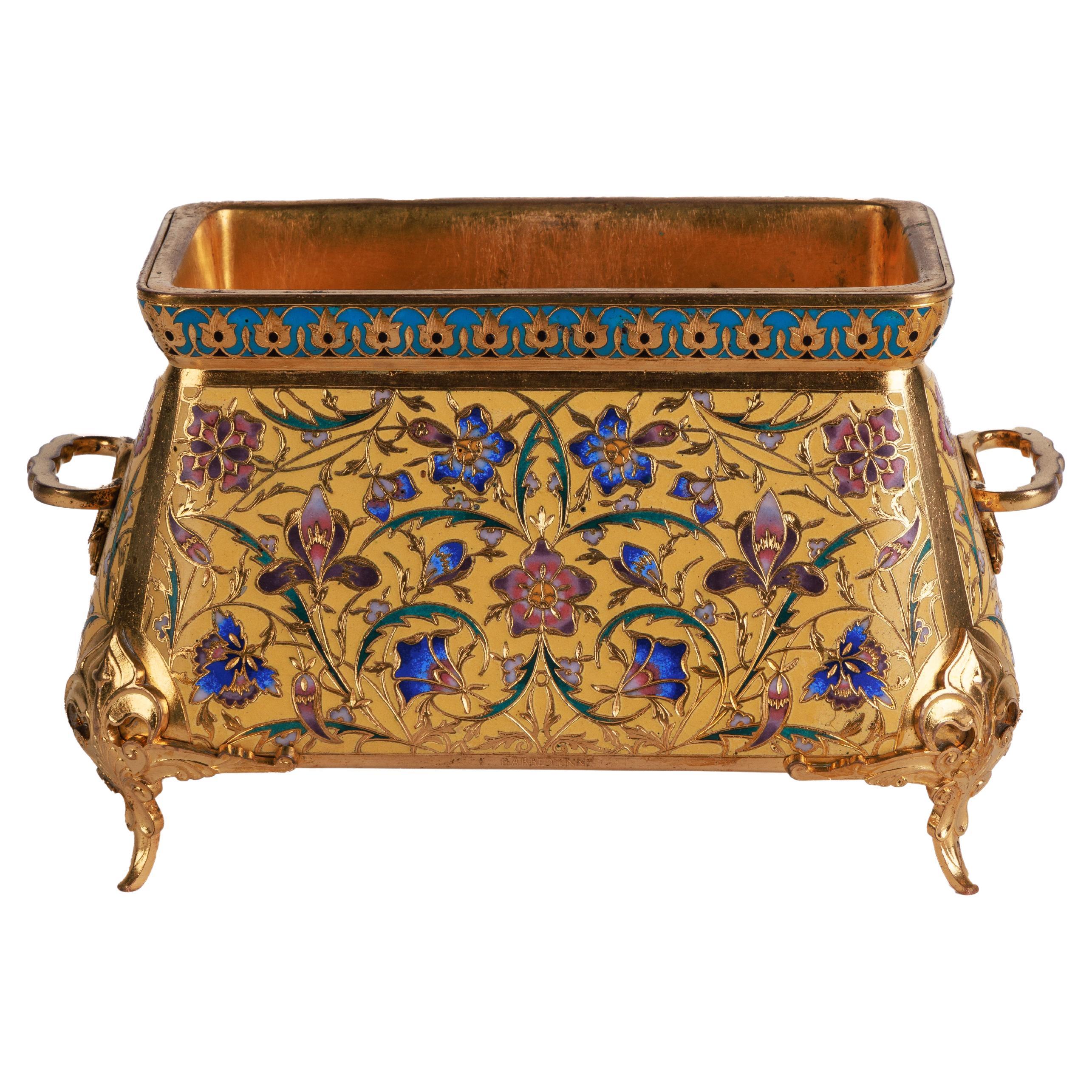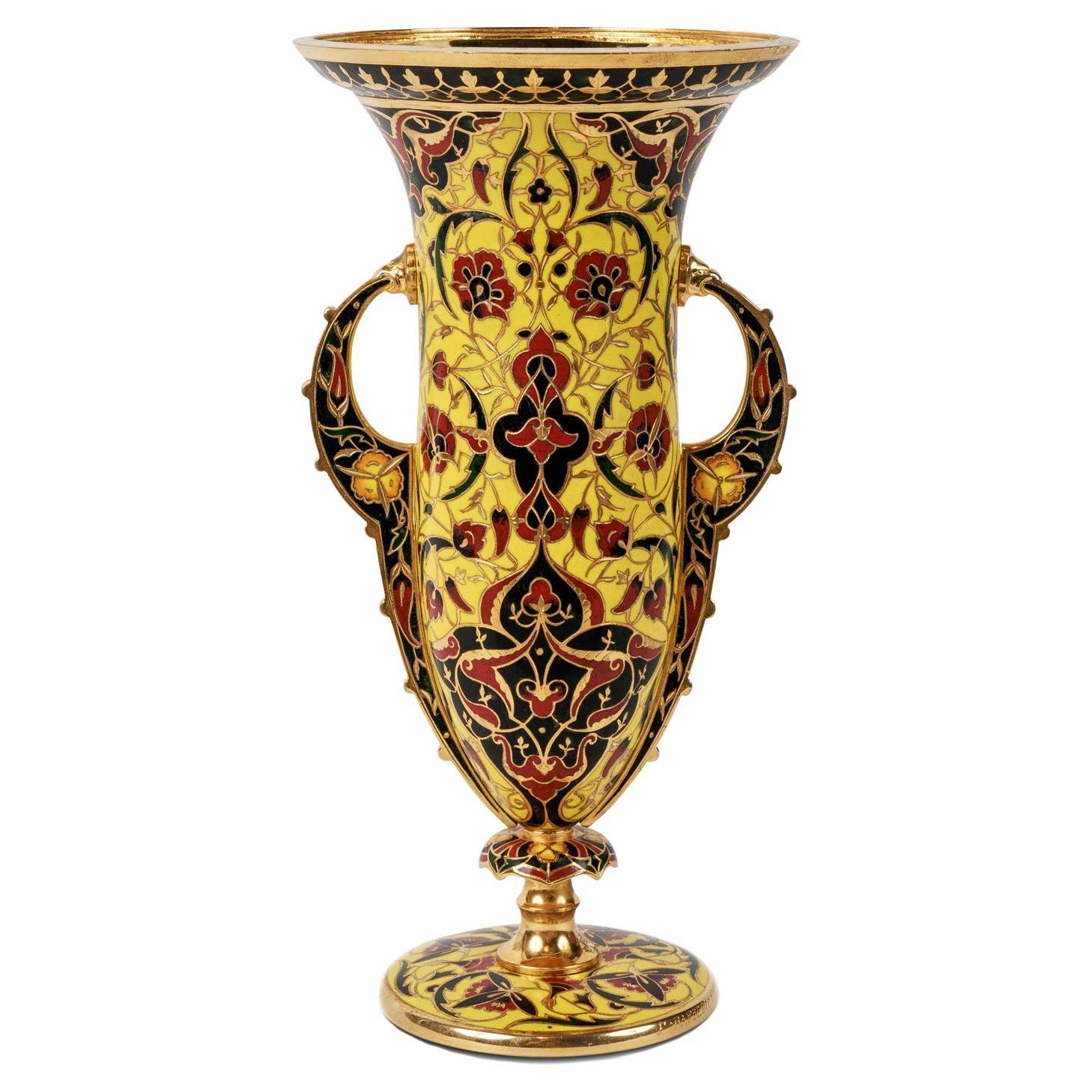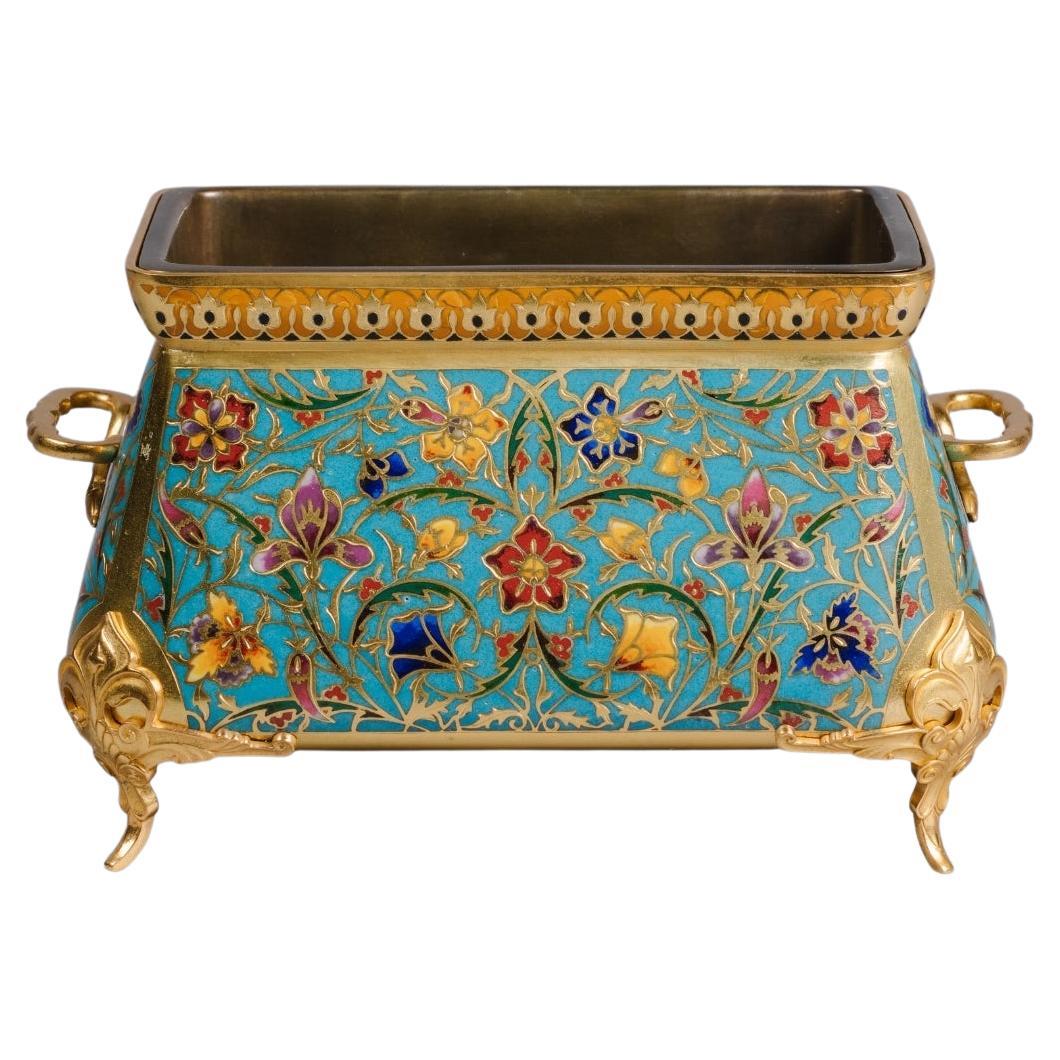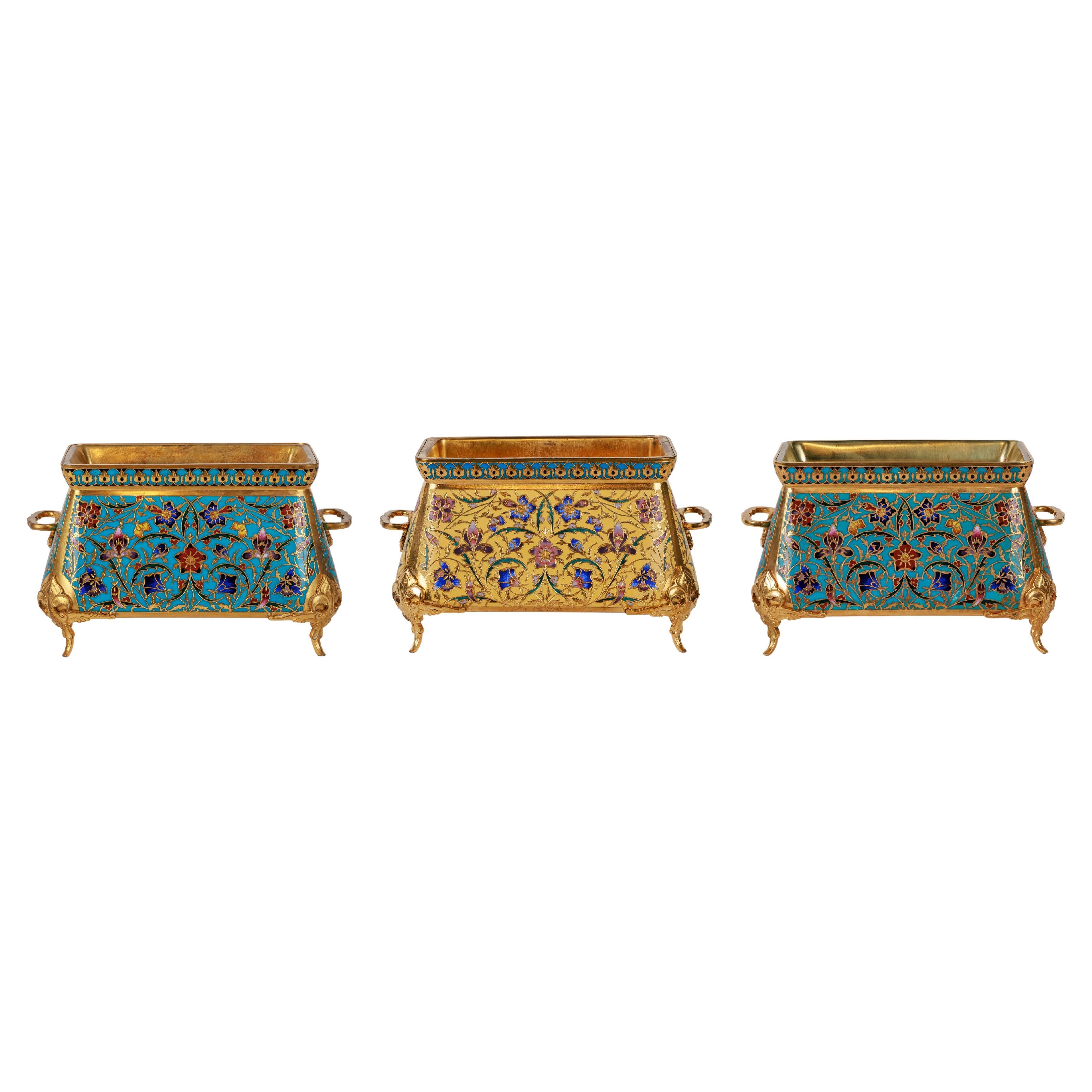Items Similar to Extremely Rare Pair of Ferdinand Barbedienne Ormolu and Champlevé Enamel Vases
Want more images or videos?
Request additional images or videos from the seller
1 of 21
Extremely Rare Pair of Ferdinand Barbedienne Ormolu and Champlevé Enamel Vases
About the Item
An extremely rare, museum quality pair of Ferdinand Barbedienne ormolu and champlevé enamel vases, circa 1870, certainly designed by Louis Constant Sevin.
Very unusual form and shape. Enameled with vibrant colors, in the Persian taste.
An identical pair is in the Musee Art Decoratifs (MAD) in Paris.
Measures: 14.5" high x 6.5" wide x 4" deep.
Each signed F. Barbedienne Fondeur, Paris
Excellent condition. Ready to place.
- Creator:Louis-Constant Sevin (Maker),Ferdinand Barbedienne (Maker)
- Dimensions:Height: 14.5 in (36.83 cm)Width: 6.5 in (16.51 cm)Depth: 4 in (10.16 cm)
- Style:Napoleon III (Of the Period)
- Materials and Techniques:
- Place of Origin:
- Period:
- Date of Manufacture:circa 1870
- Condition:
- Seller Location:New York, NY
- Reference Number:1stDibs: LU1798216692431
About the Seller
5.0
Vetted Seller
These experienced sellers undergo a comprehensive evaluation by our team of in-house experts.
Established in 1980
1stDibs seller since 2016
58 sales on 1stDibs
Typical response time: <1 hour
- ShippingRetrieving quote...Ships From: New York, NY
- Return PolicyA return for this item may be initiated within 7 days of delivery.
More From This SellerView All
- Ferdinand Barbedienne, a French Ormolu and Champleve Enamel Jardiniere, C. 1870By Louis-Constant Sevin, Ferdinand BarbedienneLocated in New York, NYFerdinand Barbedienne, A French Ormolu and Champleve Enamel Jardiniere, C. 1870, The Design Attributed to Louis Constant Sevin. An exceptional qualit...Category
Antique 19th Century French Napoleon III Decorative Bowls
MaterialsBronze, Enamel, Ormolu
- Ferdinand Barbedienne, A French Ormolu and Champleve Enamel Jardiniere, C. 1870By Louis-Constant Sevin, Ferdinand BarbedienneLocated in New York, NYFerdinand Barbedienne, A French Ormolu and Champleve Enamel Jardiniere, C. 1870, The Design Attributed to Louis Constant Sevin. An exceptional qualit...Category
Antique 19th Century French Napoleon III Planters, Cachepots and Jardini...
MaterialsBronze, Enamel, Ormolu
- Ferdinand Barbedienne, A French Ormolu and Champleve Enamel Vase, C. 1870By Ferdinand BarbedienneLocated in New York, NYFerdinand Barbedienne, A French Ormolu and Champleve Enamel Vase, C. 1870 In the Islamic / Alhambra taste. The two handled vase in Alhambra form, enameled in rich yellow throughout ...Category
Antique 19th Century French Napoleon III Vases
MaterialsBronze, Ormolu, Enamel
- Ferdinand Barbedienne, A Pair of French Ormolu and Champleve Enamel AndironsBy Ferdinand BarbedienneLocated in New York, NYFerdinand Barbedienne, A Pair of French Ormolu and Champleve Enamel Andirons, Chenets, circa 1870. A rare and unusual pair of bronze and multi-colored champleve enameled andirons / ...Category
Antique 19th Century French Napoleon III Fireplace Tools and Chimney Pots
MaterialsBronze, Enamel, Ormolu
- F. Barbedienne, A Suite of Three French Ormolu and Champleve Enamel JardinieresBy Ferdinand BarbedienneLocated in New York, NYFerdinand Barbedienne, An Exquisite Suite of Three French Ormolu and Champleve Enamel Jardinieres / Garniture C. 1870, The Design Attributed to Louis Constant Sevin. Comprising of t...Category
Antique 19th Century French Napoleon III Planters, Cachepots and Jardini...
MaterialsBronze, Enamel, Ormolu
- An Exceptional Pair of Champleve Enamel Ormolu Candelabra by Sevin & BarbedienneBy Ferdinand Barbedienne, Louis-Constant SevinLocated in New York, NYIlluminating Heritage: An Important "Exhibition" Pair of Ferdinand Barbedienne and Louis Constant Sevin Champleve Enamel and Ormolu Eight-Light Candelabra / Lamps In the realm of de...Category
Antique 19th Century French Napoleon III Candelabras
MaterialsBronze, Enamel, Ormolu
You May Also Like
- A Champlevé Enamel Jardinière by Ferdinand BarbedienneBy Louis-Constant Sevin, Ferdinand BarbedienneLocated in Brighton, West SussexA Champlevé Enamel and Gilt-Bronze Mounted Jardinière by Ferdinand Barbedienne, the design attributed to Louis-Constant Sévin. This fine jardinière is decorated all over with foliate...Category
Antique 19th Century French Planters, Cachepots and Jardinières
MaterialsBronze, Enamel
- Ormolu-Mounted and Champlevé Enamel Decorated Onyx Jardinière by BarbedienneBy Ferdinand BarbedienneLocated in New York, NYA fine quality large Neo-Grec gilt bronze-mounted and Champlevé enamel decorated onyx Jardinière by F. Barbedienne Maker: Ferdinand Barbedienne (1810-1892) Origin: French Date: ...Category
Antique Mid-19th Century French Planters, Cachepots and Jardinières
MaterialsOnyx, Bronze, Enamel
- Ferdinand Barbedienne Set of Gilt Bronze-Mounted Champleve Onyx GarnitureBy Ferdinand BarbedienneLocated in Guaynabo, PRThis is a Ferdinand Barbedienne set of gilt bronze-mounted champleve onyx garniture. It consist of two urns and one large oval vase/jardiniere. The vase...Category
Antique Late 19th Century French Empire Garniture
MaterialsOnyx, Bronze
- 19th C. French Islamic Champleve Enamel Vase and Underplate, Signed BarbedienneBy Ferdinand BarbedienneLocated in New York, NYA Fantastic 19th century French Islamic/Orientalist Style Champleve Enamel Vase and Underplate, Signed F. Barbedienne. The wide-mouthed vase terminates down a narrowing body and is m...Category
Antique 1850s French Islamic Vases
MaterialsBronze, Enamel
- Pair of 19th C. French Ormolu and Champleve Enamel Vases with Foo Lion HandlesBy Ferdinand BarbedienneLocated in New York, NYA fine and Large Pair of 19th century Orientalist Motif French Ormolu and Champlevé Enamel Vases with Foo Lion Handles of Magnificent quality and condition, Attributed to F. Barbedie...Category
Antique 1880s French Louis XVI Vases
MaterialsEnamel, Ormolu
- Pair of Trumpet-Shaped Byzantines Vases, L.C. Sevin&F. Barbedienne, France, 1880By Ferdinand Barbedienne, Louis-Constant SevinLocated in PARIS, FRSigned F. Barbedienne A pair of charming trumpet-shaped vases in gilt bronze with a polychrome cloisonné enamel decoration, one blue and the other green and red. They feature two annular handles and stand on four feet surmounted by a stylized palm. The vases are ornated with a Byzantine decoration. The high quality of the enamel is typical of Barbedienne’s production. It enhances this pair of vases especially with the wide range of colours used to create the decoration. The enamel is smooth and shiny and shows many shades to form the Byzantine decoration. The partitioned cloisonné is finely engraved and contributes to the decoration by adopting vegetal and foliage shapes. The Model These two vases can be linked to a vase presented by Ferdinand Barbedienne at the 1862 London Universal Exhibition and purchased at this time by the South Kensington Museum (now the Victoria and Albert Museum, London, Inv. 8026-1862). This vase has on its belly a polychrome cloisonné enamel decoration standing out against a turquoise background as show these vases. This decoration, called Byzantine, covers all the vase with coloured arabesques and scrolls. It rests on four claw feet with lion heads from a design near of our vases. Barbedienne and the Cloisonné Enamel Ferdinand Barbedienne continously innovated and he revived the use of enamel on art works during the second half of the 19th century. The Sèvres Manufacture enamel workshop had ever tried it in 1854-1855, but Barbedienne was the one who succeeded to join enamel to an industrial decorative objects production. From 1858 “At Mr Barbedienne’s, enamels in copper ornaments have got their former prestige back” (Les bronzes de la Maison Barbedienne, C. Simon, in L’Art du XIXe siècle, 1858, n°21, p. 252). The Barbedienne Company had now an enamel workshop where objects ornamented with oriental style or medieval style enamels were made. Four years after, Barbedienne’s cloisonné...Category
Antique 1880s French Other Vases
MaterialsBronze, Enamel
Recently Viewed
View AllMore Ways To Browse
Extremely Rare
Rare Antique Vases
Rare Antique Vase
Rare Vases Antique
Antique Enamel Vase
French Enamel Vases
French Ormolu Vases
Pair Ormolu Vases
Pair French Ormolu Vases
Pair Of Wide Louis
Antique Bathroom Colors
Champleve Enamel
Antique Enamel Bathroom Signs
19th Century Persian Vase
Barbedienne Fondeur
Persian Vessel
Champleve Vase
Ormolu Barbedienne
